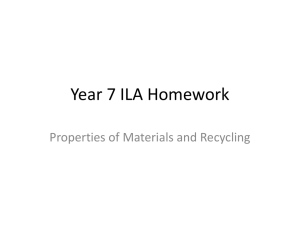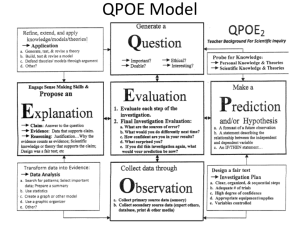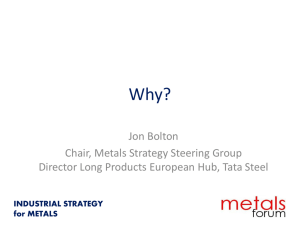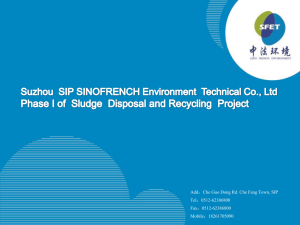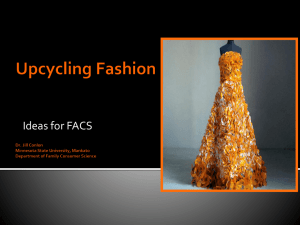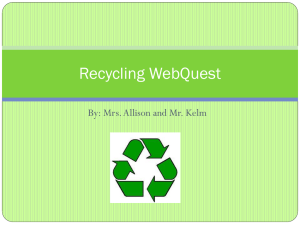RECYCLING VALUABLE METALS FROM BY-PRODUCTS
advertisement
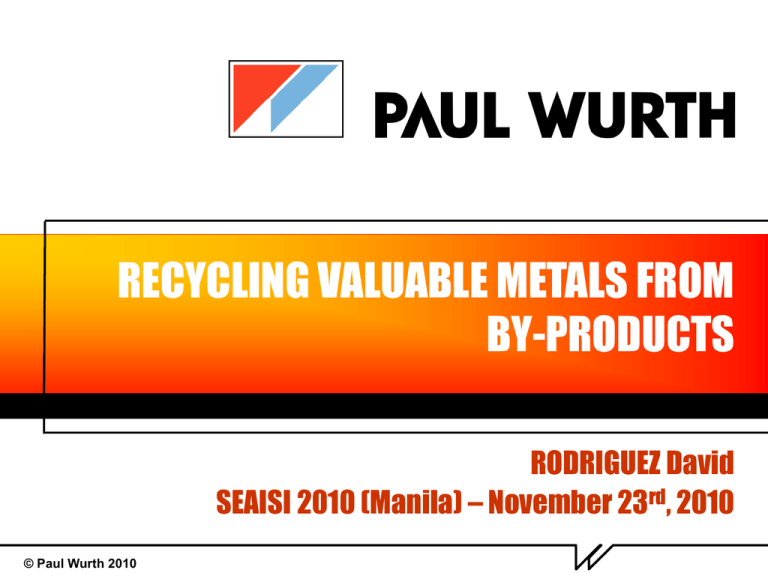
RECYCLING VALUABLE METALS FROM BY-PRODUCTS RODRIGUEZ David SEAISI 2010 (Manila) – November 23rd, 2010 © Paul Wurth 2010 INDUSTRIAL RESIDUES SITUATION Industrials are facing more and more stringent environmental regulations Dumping costs and creates environmental liabilities Extraction of valuable metals contained in residues generates financial return Look for an alternative to high cost of “virgin” raw material Challenge: solve both environmental and economical issues © Paul Wurth 2010 Recycling valuable metals from by-products SEAISI2010 2 OVERVIEW OF RESIDUES Type of waste Recoverable metals Remarks Ni, Cr, Mo, Fe Small quantities Recycling economical High product value 1 From the stainless or high alloy steel industry 2 From electric steel plants making carbon steel (EAF dust) Zn, (Fe) Larger quantities Economics depend on Zn price (treatment fee required) 3 From integrated steel plants Fe Very large quantities Economics not always favourable 4 From petrochemical industry (Spent catalysts) Mo, Ni, Co, V Small quantities High product value 5 From Copper industry Cu, (Mo) Very large quantity High product value 6 From Zn hydrometallurgy Zn, Pb, Fe, Ag Larger quantities Economics depend on Zn, Fe prices © Paul Wurth 2010 Recycling valuable metals from by-products SEAISI2010 3 PAUL WURTH EXPERIENCE IN STEELMAKING BY-PRODUCTS Activity began 15 years ago Recycling technologies: RHF technologies: RedSmelt™ / RedIron™ 60ktpy RedIron plant in Piombino (IT - 2010) Recycling of integrated steelmaking residues © Paul Wurth 2010 Recycling valuable metals from by-products SEAISI2010 4 PAUL WURTH EXPERIENCE IN STEELMAKING BY-PRODUCTS Recycling technologies: Primus® technology: MHF + EAF 75 ktpy Primus® plant in Differdange (LU - 2003) Recycling of EAF dust (60 ktpy) and oily mill sludge (15 ktpy) © Paul Wurth 2010 Recycling valuable metals from by-products SEAISI2010 5 PAUL WURTH NEW PROCESS DEVELOPMENTS i-Meltor™ furnace Adapted AC EAF equipped with bottom gas stirring and central charging between 3 electrodes Combined in Primus process with MHF or used as stand-alone PLD process PLD: Paul Wurth Lhoist Deoiling Recycling of oily mill sludge and scales in partnership with Lhoist R&D (Worldwide leader in CaO/MgO based products) © Paul Wurth 2010 Recycling valuable metals from by-products SEAISI2010 6 PAUL WURTH NEW PROCESS DEVELOPMENTS i-MELTOR™ Intensive Melting Reactor © Paul Wurth 2010 Recycling valuable metals from by-products SEAISI2010 7 i-MELTOR™ FURNACE Specific electric arc furnace for reducingmelting-settling-fuming of slag & residues © Paul Wurth 2010 Recycling valuable metals from by-products SEAISI2010 8 i-MELTOR™ : Main components Central charging duct Graphite electrode Electrodes arms Process offgas outlet Water cooled cover Slag Spray coolers Slag door Hot metal Refractory lining Transfer car Bottom gas stirring © Paul Wurth 2010 Recycling valuable metals from by-products SEAISI2010 9 i-MELTOR™ : Process key features Central charging Accept fines High specific power 1 MW/m2 Compact design Controlled bottom gas stirring Enable multi-step processes (melting, reducing, refining, settling, fuming) Combination of these 3 key features ensures high melting kinetics © Paul Wurth 2010 Recycling valuable metals from by-products SEAISI2010 10 i-MELTOR™ : References 6 t pilot EAF PRIMOREC EAF DSC EAF Ø2m int. 3 MW Ø3,5m int. 10 MW Ø6m int. 21 MW © Paul Wurth 2010 Recycling valuable metals from by-products SEAISI2010 11 i-MELTOR™ : Technological highlights Spray coolers Key features • Increased lifetime of refractory lining in the slag zone • Pressure less cooling system • Operated in safe conditions in case of breakthrough With staves © Paul Wurth 2010 Recycling valuable metals from by-products SEAISI2010 Without staves 12 i-MELTOR™ : Technological highlights Offgas cleaning system Components Quench Water cooled elbow + jacket Post combustion chamber Quench tower Baghouse filter PCC • • • • Filter unit Adapted to comply with lowest emission limits © Paul Wurth 2010 Recycling valuable metals from by-products SEAISI2010 13 i-MELTOR™ : Opportunities © Paul Wurth 2010 EAF dust SS dust & sludge Waelz slag Fe Zn Ni Cr Zn Fe Zn Spent catalysts Cu slag & residues Leaching residues Mo Ni Co Cu Ni Mo Zn Zn Ag In Recycling valuable metals from by-products SEAISI2010 14 i-MELTOR™ : Applications - Recycling of stainless steel dust and sludge Application SS dust & sludge In place of SAF Input: 80-200kt/y pre-reduced product SS dust & sludge Output: NiCr alloy Application Input: dust with 4% Zn, 4% Cr and 2% Ni ZnO Output: NiCr alloy and ZnO ZnO NiCr alloy © Paul Wurth 2010 Inert slag 10 to 70 kty dust NiCr alloy Recycling valuable metals from by-products SEAISI2010 Inert slag 15 PAUL WURTH NEW PROCESS DEVELOPMENTS PLD PROCESS Paul Wurth Lhoist Deoiling © Paul Wurth 2010 Recycling valuable metals from by-products SEAISI2010 16 Oily sludge & scales - Treatment sinter Energy consumption coking coal Ore Limited (Dioxins) Requires hard briquettes coke Reduces burden permeability Penalizes BF performances Reduces PCI capacity High T° Pyroprocesses Requires more coke hot metal Abrasion issue Requires charge preparation Disturbs process Impacts steel quality (S) Oily scale / sludge Cost Liabilities © Paul Wurth 2010 Recycling valuable metals from by-products SEAISI2010 dump 17 PLD PROCESS : Basic principles Oily by-product HC: 2-20% H2O: 10-30% Air Offgas CO < 50 ppm VOC < 10 ppm MIXING SELF-HEATING SOFT CONTROLLED OXIDIZING CaO: 5-15% Up to 500°C © Paul Wurth 2010 Recycling valuable metals from by-products SEAISI2010 Dry powder HC < 0,1% CaCO3 18 PLD PROCESS : Driving parameters Quantity of CaO Residence Time Air injection © Paul Wurth 2010 Recycling valuable metals from by-products SEAISI2010 19 PLD PROCESS : Test performances – Continuous pilot test Trial #2 Trial #3 #4 Trial #5 #6 #7 600 Sludge: 18~20% oil; 20% H2O 500 Scales: 1~2% oil; 2~10% H2O 400 Mix: 2-4-8-10% oil; 9-11-20% H2O 29/10/2009 14:00 29/10/2009 06:00 28/10/2009 22:00 28/10/2009 14:00 28/10/2009 06:00 27/10/2009 22:00 27/10/2009 14:00 Main conclusions: Auto thermal process proven Throughput: 100 kg mix/h De-oiling down to 0.1% achieved + 0 - 5 - 10% lime Residence time: 60 min PC of offgas efficient 27/10/2009 06:00 200 26/10/2009 22:00 300 26/10/2009 14:00 Average furnace temperature (°C) Trial #1 Time Test duration: 4 Days Temperatures : 500 - 400 - 300 °C 2 Continuous test campaigns: 8 hours / 4 days © Paul Wurth 2010 Recycling valuable metals from by-products SEAISI2010 20 PLD PROCESS : Industrial plant flowsheet Lime Handling Material Handling Sludge Handling Offgas MHF © Paul Wurth 2010 Recycling valuable metals from by-products SEAISI2010 21 PLD PROCESS : Industrial plant layout Sludge Handling Lime Handling ~ 20 m Offgas MHF © Paul Wurth 2010 Recycling valuable metals from by-products SEAISI2010 22 PLD PROCESS : Industrial plant typical design • Multiple Hearth Furnace: - 6 hearths - internal diameter: 3,5 / 5 m - compact furnace with insulated steel casing • Annual production 25 000 / 75 000 tpy (wet - oily) • Availability > 95 % • Sludge rating 3~10 t/h (wet) • Lime charging capacity 0,1~1,5 t/h (5-15%) • Output: “iron oxide” • Residual oil content < 0,1% © Paul Wurth 2010 Recycling valuable metals from by-products SEAISI2010 23 PLD PROCESS : Industrial plant typical design • Costs: - Range of total investments: 8~12 mio€ - Range of operating costs: 20~40 €/t oily sludge • Credits: - Value of output: 70~85 €/t iron oxide - Dumping cost avoided: ~70 €/t oily sludge - Transport cost avoided: ~10€/t oily sludge © Paul Wurth 2010 Recycling valuable metals from by-products SEAISI2010 24 PLD PROCESS : Process profitability for 75ktpy PLD plant (EXAMPLE) © Paul Wurth 2010 Recycling valuable metals from by-products SEAISI2010 25 CONCLUSIONS By-products recycling becomes a priority for industrials “Zero waste” technologies will be a key point for the sustainability of metallurgical operations in the near future © Paul Wurth 2010 Recycling valuable metals from by-products SEAISI2010 26 THANK YOU FOR YOUR ATTENTION © Paul Wurth 2010 Recycling valuable metals from by-products SEAISI2010 27


